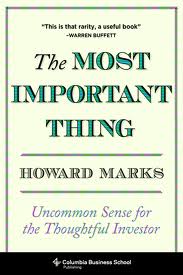There must be something in the Whitebox water supply: it's producing an army of investment math nerds with acute self-awareness and sensibilities, led by their fearless leader Andy Redleaf. Those of you who have not yet seen Whitebox's "10 Enduring Principles To Interpret Constant Market Change" are missing out -- it is absolutely worth three minutes of your day. The text below is extracted from a Jan 2015 Andy Redleaf article titled "Getting Past the Romance of Risk":
“The courage to ‘take a chance.’ The fearlessness of being a ‘risk taker.’ Risk as the force of entrepreneurship. These ideas are so ingrained in the American psyche that in the investment industry they have become dogma: to increase returns the investor must be willing to accept more risk. That is the core result of Modern Portfolio Theory, even if it is hedged with theories about how to accept risk systematically on the “efficient frontier.”
Given this persistent quasi-romance with risk, we have to ask: What great investor or entrepreneur ever succeeded by deliberately taking on more risk?
...the entrepreneur’s goal should always be to create asymmetries of risk and reward in which there is far more to be gained than lost. We strongly believe all investment managers should be doing the same, which is why the first of Whitebox’s 10 Investment Principles is: The source of investment return is the efficient reduction of risk.
If risk is not the basis of return, should an investor strive to take no risk at all? No. There is no such thing as a risk-free portfolio. We believe that the right goal is to reduce risk efficiently: reduce the risks of a position more than one reduces its potential return. One can do this in various ways, but it comes down to the investor striving to own only and exactly what he wants to own…
How do we believe an investor can own only and exactly what he wants to own? In practical terms, what does this look like?
In reality, most securities, taken individually, are bundles of both good and bad qualities. Even a stock that presents generally favorable prospects for potentially good returns is likely to contain at least some unfavorable qualities; the same is generally true for bonds. As such, we believe the key – and the whole point of alternative investing – is to be able to identify and isolate the good from the bad, so that you own only and exactly what you want.
How is this achieved? Sometimes this is done at the security level, by buying securities with desirable qualities and canceling out the undesirable qualities through carefully constructed positions in our short book. Sometimes it is done at the portfolio level, by combining investment “themes” in ways that retain the attractive qualities of an investment idea while, hopefully, canceling out the risks.
Sometimes, it can be achieved by striving to identify and implement hedges that are in themselves what we perceive as sound, attractive investments, the goal being to reduce risk through tactics and decisions that are themselves potentially return-generating investments…
Viewing risk-reduction in itself as a source of potential returns is in stark contrast to a more traditional approach, which we believe accepts some measure of loss in exchange for potential payoff.
Exercising sound judgment in investing, we believe, involves choosing the particular over the abstract. This can mean the difference between buying up “lots” of securities in bundles (often to satisfy a predetermined allocation percentage, for example) versus sorting through individual names, looking for nuances lurking beyond-the-obvious that enhance value, and identifying idiosyncratic dislocations – even among securities that are bought and sold in “lots.” It means looking at risk specifically, not from a high level of abstraction, striving to reduce that risk efficiently through a hedge that in itself is an investment with potential payoff.
Put another way, we believe efficient reduction of risk begins with and cannot be separated from the investment process. To us, every investment decision, therefore, should be a decision about risk. We reject the concept of risk management as an “overlay.”
Most of all, we believe this investment principle entails viewing risk and risk mitigation as a matter of judgment. We feel confident in our belief that investors who exercise good judgment are more likely to prosper than investors who do not…
Seen from this perspective, the concept of risk is somewhat reframed. We simply reject the idea that says “the greater the risk, the greater potential for return.” To us, a truly alternative approach to investing involves what we believe to be a fairly straightforward endeavor: efficiently reduce risk so as to own only and exactly what you want to own.”
On efficient markets: “We believe this…approach to investing isn’t safe, mostly because we see it as lazy. On every point listed above, we’re convinced that money managers who go along with these dogmas are saving themselves work, but risking investors’ money.”


















